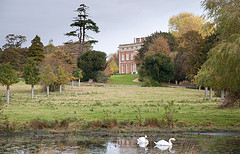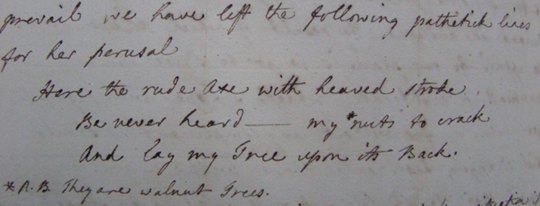 George Grenville (1712-1770) is not necessarily a household name in garden history. Better known for his political life, George Grenville is more famous for his period as Prime Minister (16 April 1763 – 13 July 1765) and for his earlier involvement with the navy. Yet he lived at Wotton (as he called it himself, or Wotton House) in Buckinghamshire when Lancelot Brown worked there in the years 1742-46. 1At the time of publishing this post I found out there is a complete issue of New Arcadian Journal devoted to the gardens at Wotton House and the involvement of the Grenville family therein. New Arcadian Journal 65/66 (2009). See the link in this footnote. I have not been able to get my hands on that, yet.
George Grenville (1712-1770) is not necessarily a household name in garden history. Better known for his political life, George Grenville is more famous for his period as Prime Minister (16 April 1763 – 13 July 1765) and for his earlier involvement with the navy. Yet he lived at Wotton (as he called it himself, or Wotton House) in Buckinghamshire when Lancelot Brown worked there in the years 1742-46. 1At the time of publishing this post I found out there is a complete issue of New Arcadian Journal devoted to the gardens at Wotton House and the involvement of the Grenville family therein. New Arcadian Journal 65/66 (2009). See the link in this footnote. I have not been able to get my hands on that, yet.
His uncle, Viscount Cobham, and later his elder brother Richard Grenville are household names in some respect, although in garden historical circles their garden at Stowe has acclaimed a much higher level of fame than the men who owned it.
All in all, enough reason for me to dive into some of the family correspondence, looking for (of course) completely different stuff than I ended up finding. In the National Archives at Kew I flipped through some of George’s letters, in this case written to his sister Hester Grenville, also known as Hester Pitt, Countess of Chatham. 2The National Archives, PRO 30/8/34/1, letters from George Grenville, her second brother [to Hester Pitt, born Grenville -HvdE], 1746-1770. It is no surprise that their family’s gardens do come up in conversation sometimes. In 1760, for example, the Stowe part of the family made fun of George’s up till then futile attempts to get his lakes at Wotton filled with water -while their ‘new rivers‘ had filled up just fine, of course. 3The National Archives, PRO 30/8/34/1, letter from George Grenville to Hester Pitt, June 27, 1760: ‘His [Lord Temple / Richard Grenville] letter is in very high spirits, not without some degree of insolence upon the dry bottoms of our lakes at Wotton compar’d with the new rivers which are making & filling at Stowe, (…).’
But George Grenville also had an eye for smaller properties, and seems to have had strong ideas about the smallest issues. In July 1749 he writes about visiting a small property in Cookam, while on their way to nearby Cliveden (yet another big garden, a few miles east of Cookam). The house belonged to a certain Mrs Edwards, who at the time of Grenville’s visit had not yet returned from Bristol. 4The name of the place is never mentioned, and although this Cookam Parish description from 1923 mentions several bigger houses and manors, I haven’t been able to tie one of them to the property mentioned in George’s letter. The party nonetheless took possession of the kitchen, and enjoyed a meal. Grenville describes the house as ‘the prettiest gayest retirement I ever saw‘, but mentions that ‘the house is small and not extremely convenient‘ and that it would be impossible to live there during winter.
He goes on and writes to his sister that they were told of plans to cut down three trees -the only three on the property, George tells us. The party strongly opposed these plans, but what to do? In the absence of Mrs Edwards and thus incapable of convincing her to leave the trees be, they left her (in his words) ‘the following pathetick lines for her perusal‘:
Here the rude Axe with heaved stroke
Be never heard – my *nuts to crack
And lay my Tree upon its Back.

Poem in a letter from George Grenville to his sister Hester, July 9, 1749.
Grenville must have realized that the second half of this poem might spur some…, well… confusion. For his sister’s benefit, he added an asterisk in front of the word ‘nuts’, and the following explanation: *N.B. They are walnut Trees.
Ah! Thank you, George. A necessary explanation indeed. But I wonder whether he left the same explanation for poor Mrs Edwards…
Footnotes
| ↑1 | At the time of publishing this post I found out there is a complete issue of New Arcadian Journal devoted to the gardens at Wotton House and the involvement of the Grenville family therein. New Arcadian Journal 65/66 (2009). See the link in this footnote. I have not been able to get my hands on that, yet. |
|---|---|
| ↑2 | The National Archives, PRO 30/8/34/1, letters from George Grenville, her second brother [to Hester Pitt, born Grenville -HvdE], 1746-1770. |
| ↑3 | The National Archives, PRO 30/8/34/1, letter from George Grenville to Hester Pitt, June 27, 1760: ‘His [Lord Temple / Richard Grenville] letter is in very high spirits, not without some degree of insolence upon the dry bottoms of our lakes at Wotton compar’d with the new rivers which are making & filling at Stowe, (…).’ |
| ↑4 | The name of the place is never mentioned, and although this Cookam Parish description from 1923 mentions several bigger houses and manors, I haven’t been able to tie one of them to the property mentioned in George’s letter. |



